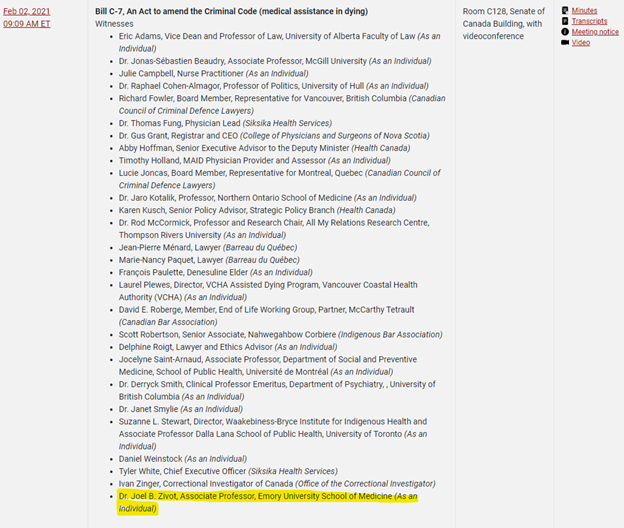I am responding to the letter printed in the “Letters to the Editor” by Garry R. Thompson, in your April 10th edition of the Moose Jaw Express discussing my presentation to the Moose Jaw Right to Life Society about “M.A.i.D.”
Mr. Thompson, sharing that he sat through a “MAiD“ death, appears to be a proponent of the procedure. He assured us that although it was “sad” he observed the person, “soon comfortably adrift off into a deep sleep - completely at peace”. Once the patient was pronounced dead by the Dr., Thompson ends by saying, “we were relieved to see the patient finally released and at peace”.
I direct you, and your readers, to the testimony of Dr. Joel B. Zivot who was a witness in front of the Senate of Canada, Standing Committee on Legal and Constitutional Affairs, during the Bill C-7 hearings in 2021. I have attached the complete transcript herein.
Dr. Joel has 25 years experience in anesthesiology and critical care medicine including pharmacology of many of the medications that are used here in Canada for “MAiD”.
One of his research interests led him to study lethal injections as a form of death-row execution in the U.S.
His testimony states:
“When one watches an execution, it’s not clear that this is happening. There is not much to see. Executions, like, I imagine medical assistance in dying, are a rather bloodless event; not much can be seen outwardly. But the autopsies revealed a very disturbing and surprising finding.”
He goes on to say, “.. when a person dies by lethal injection, they basically drown. Their lungs fill with fluid, and I would describe that the experience of dying under that circumstance is more akin to death by water boarding, which we recognize as cruel.”
He clarifies by saying, “When I look at the method of dying by medical assistance in dying, the technique is strikingly similar. The pharmacology is similar in design to the death by lethal injection in the United States”.
And perhaps the most important section for your readers to absorb is what Dr. Zivot says next, “what is most distressing about this is the fact that MAiD includes in its protocol the use of a paralyzing drug. Once a paralyzing drug is given, a person can no longer move. To claim that this is a death that is peaceful, well, it can be nothing else because now a person is unable to move in any way.”
As an ending punch, Dr. Zivot testifies, “Paralytics are not even used in the U.S. as part of euthanizing animals, so the fact that we are using them in medical assistance in dying is most distressful.”
Perhaps, Mr. Thompson should do a bit more research other than just accepting the words “dignity” from a national lobby group that receives millions of dollars from both government and private donors to further the practice of euthanasia across Canada.
By the way, the banquet was awesome, the food was great and the people even greater!
Sincerely,
Angelina Ireland
Executive Director
Delta Hospice Society
Below is the above mentioned testimony of Dr. Joel B. Zivot:

The Chair: Thank you very much, Ms. Roigt, and you are right that it was Senator Dalphond who wanted us to hear from you. He was right, so thank you very much for being here.
We go next to Dr. Joel Zivot. He is an associate professor at Emory University and adjunct professor of law at Emory Law School.
Dr. Joel B. Zivot, Associate Professor, Emory University School of Medicine, Vancouver Coastal Health Authority (VCHA), as an individual: Thank you for the opportunity to speak today. I see once again that I must suffer the perils of having my name begin with a letter zed, so I come up at the end, or as in America we say zee.
The Chair: You are not at the end.
Dr. Zivot: Thank you for the opportunity to speak with you today. I’m going to talk about something that I don’t think has been specifically addressed up to now.
My area of focus here is on my concerns about Bill C-7, which will, in some circumstances, expand access to MAID, but my claim here is that the technique of MAID will produce death that will be in a manner that is painful and akin to drowning. The Canadians who seek MAID must understand that MAID employs a technique that will very likely cause painful dying.
Now, I’m not here to debate the rightness or wrongness of MAID. That is for others. I’m going to confine my concerns here to the technical aspects, and I’m going to explain to you what I suspect it feels like when one is killed by MAID. So what does it feel like to die when the cause of death is MAID?
Just to give a little bit of background about myself, I am a Canadian citizen. I’m a physician. I went to medical school at the University of Manitoba, and then I did my residency at the University of Toronto in anesthesiology. After that, I went to the Cleveland Clinic in Cleveland, Ohio, and did my fellowship in critical care medicine. I have been practising anesthesiology and critical care medicine for more than 25 years both in the U.S. and Canada. I consider myself an expert in both of these fields, including the pharmacology of many of the medications that are used here in MAID.
A number of years ago, I discovered that a drug called sodium thiopental that I and all anesthesiologists commonly used at the beginning of an anaesthetic, disappeared from the world market. I wondered how that could be, so, of course, logically, I investigated to see if I could determine what happened to sodium thiopental.
My investigation led me to the last company that was manufacturing sodium thiopental, a company called Hospira. At the time, Hospira was manufacturing sodium thiopental in Italy, and Italy, being a member of the EU, was under the rules of the EU, which stipulate that no company can produce a compound that will be used for the purposes of execution. Hospira understood that the sodium thiopental it was making was being used for execution in the United States, so it decided to cease manufacturing. Execution basically eliminated the production of sodium thiopental. I was dismayed, of course, because I thought here was a drug made for the purposes of medicine, and now it was being repurposed for killing.
I then became interested in lethal injection as a form of execution in the United States. Again, as a Canadian citizen, this was all new to me. Canada, of course, does not use execution as a form of punishment, but in the U.S., it is a lawful form of punishment, under certain provisions, specifically, that it must not violate the eighth amendment of the U.S. Constitution, which proscribes any cruelty in the setting of punishment. There are other techniques that are used to execute individuals, but lethal injection is the common technique used currently.
A few years ago, I was handed a file that was a series of autopsies. Within this file were individuals who had been executed by lethal injection, and I was asked as an expert to look to see whether I could speculate that the blood levels of the pentobarbital, in this case, would be sufficient and likely to cause death in these individuals. I looked at that but also discovered that what I was handed was, in fact, entire autopsies of individuals, so it included the gross description of organs within the body.
When I looked at the autopsies, to my surprise, I found that, in most of the cases, the individuals who had been executed by pentobarbital had fluid congested in their lungs. The lungs of these individuals were twice the normal weight, full of water. Now, the only way that this could have happened would have been as a direct consequence of the pentobarbital that was injected into these individuals. When one watches an execution, it’s not clear that this is happening. There is not much to see. Executions, like, I imagine, medical assistance in dying, are a rather bloodless event; not much can be seen outwardly. But the autopsies revealed a very disturbing and surprising finding.
Now, with this information in hand, I approached a journalist and became connected with journalists at National Public Radio here in the United States, and they undertook a freedom of information investigation and collected 300 autopsies of individuals executed in the United States, the largest collection ever brought together. Two hundred of those autopsies showed findings in the lungs, and again, in 85% of the cases, the lungs were filled with fluid.
What does this mean? It means that when a person dies by lethal injection, they basically drown. Their lungs fill with fluid, and I would describe that the experience of dying under that circumstance is more akin to death by waterboarding, which we recognize to be cruel.
Now, I will tell you that when I looked at the method of dying by medical assistance in dying, the technique is strikingly similar. The pharmacology is similar in design to the death by lethal injection in the United States, and it is stated that the autopsies performed on inmates executed show the presence of significant quantities of fluid, and in my comments that I sent earlier, I link to the National Public Radio story that goes into this in more detail.
The Chair: Dr. Zivot, could you wrap up, please?
Dr. Zivot: Sure.
Let me add that what is most distressing about this is the fact that MAID includes in its protocol the use of a paralyzing drug. Now, once a paralyzing drug is given, a person can no longer move, so all bets are off. To claim that this is a death that is peaceful, well, it can be nothing else because now a person is unable to move in any way, but whether or not they have any conscious experience of what is happening is unknown. I will tell you again that paralytics are not even used in the United States as part of euthanizing animals, so the fact that we are using them in medical assistance in dying is most distressing.
Finally, I would say that it’s important that if MAID is to be used, it should be clear to the Canadian public that the kind of death that they will experience as a consequence of MAID will be something other than the way it is represented. It could be exceedingly painful and more akin to drowning.
I will now take questions. Thank you.
The Chair: Thank you very much. We will now go to Dr. Janet Smylie. She is a director of Well Living House Action Research Centre for Indigenous Infant, Child and Family Health and Wellbeing at St. Michael’s Hospital, is a Métis physician, has experience in addressing inequalities in the health of Indigenous peoples, including developing guidelines for health care professionals working with Indigenous peoples.
The views and opinions expressed in this article are those of the author, and do not necessarily reflect the position of this publication.




